Investigation on Insulated, Brain-Implanted Antenna for Highly Reliable Biotelemetry Communication in MICS and ISM Bands
Abstract
1. Introduction
2. Derivation and Validation of Analytic Solution
2.1. The Derivation of an Analytical Soultion
2.2. Validation of the Analytical Solution Using a Numerical Simluator
3. Insulator Layer and Radiation Mode
3.1. Effect of the Commercially Biocompatible Insulators
- MPTErel is higher with thicker insulators.
- MPTErel of the TM mode varies according to insulator material but is almost negligible for TE radiation.
- As frequency increases, the effect on MPTErel by insulator type and the difference in both TM and TE mode MPTErel decreases.
3.2. The Effects of Variation in Dielectric Properties of Insulators
3.3. Lossless Air Region
3.4. Radiation Mode
4. Conclusions
Author Contributions
Funding
Conflicts of Interest
Appendix A
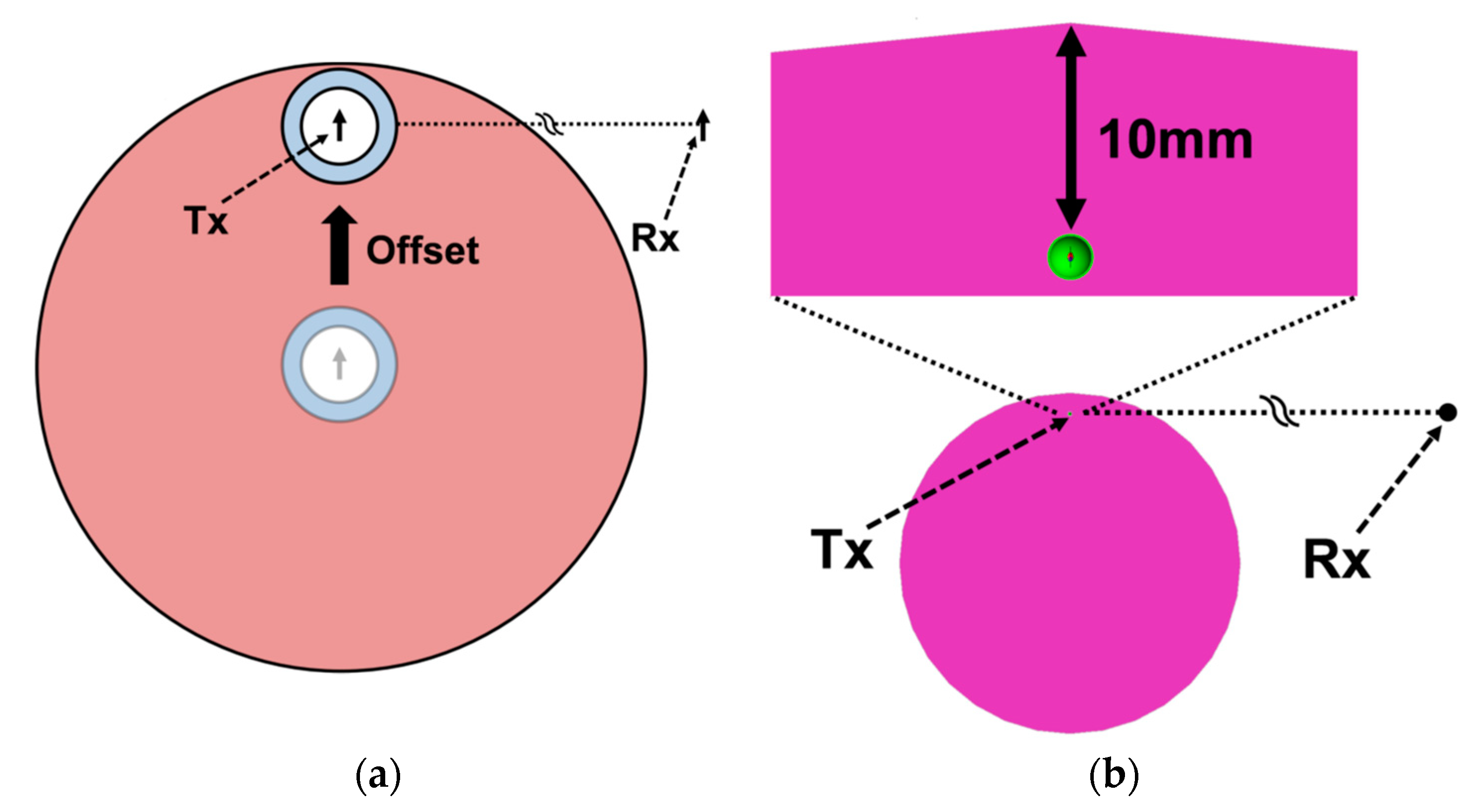

Appendix B
| Acronym (Abbreviation) | Definition |
|---|---|
| MPTE | maximum power transfer efficiency |
| MICS | medical implant communication system |
| ISM | industrial, scientific and medical |
| UWB | ultra-wideband |
| MSS | multi-layered spherical shell |
| Tx | transmitting antenna |
| Rx | receiving antenna |
| MPTErel | relative maximum power transfer efficiency |
References
- Lee, C.W.L.; Kiourti, A.; Chae, J.; Volakis, J.L. A high-sensitivity fully passive neurosensing system for wireless brain signal monitoring. IEEE Trans. Microw. Theory Tech. 2015, 63, 2060–2068. [Google Scholar] [CrossRef]
- Kiourti, A.; Lee, C.W.L.; Chae, J.; Volakis, J.L. A wireless fully passive neural recording device for unobtrusive neuropotential monitoring. IEEE Trans. Biomed. Eng. 2016, 63, 131–137. [Google Scholar] [CrossRef] [PubMed]
- Song, L.; Rahmat-Samii, Y. An end-to-end implanted brain-machine interface antenna system performance characterizations and development. IEEE Trans. Antennas Propag. 2017, 65, 3399–3408. [Google Scholar] [CrossRef]
- Merli, F.; Bolomey, L.; Zürcher, J.-F.; Corrandini, G.; Meurville, E.; Skrivervik, A.K. Design, realization and measurements of a miniature antenna for implantable wireless communication system. IEEE Trans. Antennas Propag. 2011, 59, 3544–3555. [Google Scholar]
- Kiourti, A.; Nikita, K.S. Miniature scalp-implantable antennas for telemetry in the MICS and ISM bands: Design, safety considerations and link budget analysis. IEEE Antennas Propag. 2012, 60, 3568–3575. [Google Scholar] [CrossRef]
- Liu, C.; Guo, Y.-X.; Xiao, S. Capacitively loaded circularly polarized implantable patch for ISM band biomedical applications. IEEE Tans. Antennas Propag. 2014, 62, 2407–2417. [Google Scholar] [CrossRef]
- Bahrami, H.; Mirbozorgi, S.A.; Ameli, R.; Rusch, L.A.; Gosselin, B. Biological channel modeling and implantable UWB antenna design for neural recording systems. IEEE Trans. Biomed. Eng. 2015, 62, 88–98. [Google Scholar] [CrossRef]
- Merli, F.; Fuchs, B.; Mosig, J.R.; Skrivervik, A.K. The effect of insulating layers on the performance of implanted antennas. IEEE Trans. Antennas Propag. 2011, 59, 21–31. [Google Scholar]
- Bosiljevac, M.; Sipus, Z.; Skrivervik, A.K. Propagation in finite lossy media: An application to WBAN. IEEE Antennas Wireless Propag. Lett. 2015, 14, 1546–1549. [Google Scholar] [CrossRef]
- Skrivervik, A.K.; Bosiljevac, M.; Sipus, Z. Fundamental limits for implanted antennas: Maximum power density reaching free space. IEEE Trans. Antennas Propag. 2019, 67, 4978–4988. [Google Scholar] [CrossRef]
- Kim, J.; Rahmat-Samii, Y. Implanted antennas inside a human body: Simulations, designs, and characterizations. IEEE Trans. Microw. Theory Tech. 2004, 52, 1934–1943. [Google Scholar] [CrossRef]
- Nikita, K.S.; Stamatakos, G.S.; Uzunoglu, N.K.; Karafotias, A. Analysis of the interaction between a layered spherical human head model and finite-length dipole. IEEE Trans. Microw. Theory Tech. 2000, 48, 2003–2012. [Google Scholar]
- Reyhani, S.M.S.; Ludwig, S.A. An implanted spherical head model exposed to electromagnetic fields at a mobile communication frequency. IEEE Trans. Biomed. Eng. 2006, 53, 2092–2101. [Google Scholar] [CrossRef]
- Tai, C.T.; Collin, R.E. Radiation of a Hertzian dipole immersed in a dissipative medium. IEEE Trans. Antennas Propag. 2000, 48, 1501–1506. [Google Scholar] [CrossRef]
- Karlsson, A. Physical limitations of antennas in a lossy medium. IEEE Trans. Antennas Propag. 2004, 52, 2027–2033. [Google Scholar] [CrossRef]
- Shin, G.; Yoon, I.-J. Analytic study on the small antennas coupling for wireless biotelemetry. In Proceedings of the International Symposium on Antennas and Propagation (ISAP 2018), Busan, Korea, 23–26 October 2018. [Google Scholar]
- Evaluating Compliance with FCC Guidelines for Human Exposure to Radiofrequency Electromagnetic Fields, 97-01 ed.; Supplement C, OET Bulletin 65; Federal Communication Commission (FCC) Std.: Washington, DC, USA, 2001.
- Lee, J.; Nam, S. Fundamental aspects of near-field coupling small antennas for wireless power transfer. IEEE Trans. Antennas Propag. 2010, 58, 3442–3449. [Google Scholar]
- Harrington, R.F. Time-Harmonic Electromagnetic Fields; IEEE Press: New York, NY, USA, 2001; p. 460. [Google Scholar]
- Yoon, I.-J.; Ling, H. Investigation of near-field wireless power transfer in the presence of lossy dielectric materials. IEEE Trans. Antennas Propag. 2013, 61, 482–488. [Google Scholar] [CrossRef]
- Balanis, C.A. Antenna Theory: Analysis and Design, 3rd ed.; Wiley-Interscience: New York, NY, USA, 2005; pp. 476–478. [Google Scholar]
- Drossos, A.; Santomaa, V.; Kuster, N. The dependence of electromagnetic energy absorption upon human head tissue composition in the frequency range of 300–3000 MHz. IEEE Trans. Microw. Theory Tech. 2000, 48, 1988–1995. [Google Scholar]
- Pfeiffer, C. Fundamental efficiency limits for small metallic antennas. IEEE Trans. Antennas Propag. 2017, 65, 1642–1650. [Google Scholar] [CrossRef]
- Thal, H.L., Jr. New radiation Q limits for spherical wire antennas. IEEE Trans. Antennas Propag. 2006, 54, 2757–2763. [Google Scholar] [CrossRef]
- Best, S.R. The radiation properties of electrically small folded spherical helix antennas. IEEE Trans. Antennas Propag. 2004, 52, 953–960. [Google Scholar] [CrossRef]
- Kong, M.; Shin, G.; Lee, S.-H.; Yoon, I.-J. Investigation of 3D printed electrically small folded spherical meander wire antenna. J. Electromagn. Eng. Sci. 2017, 17, 228–232. [Google Scholar] [CrossRef]
- Kim, O.S. Low-Q electrically small spherical magnetic dipole antennas. IEEE Trans. Antennas Propag. 2010, 58, 2210–2217. [Google Scholar] [CrossRef]
- Ha, S.-G.; Cho, J.; Jung, K.-Y. Design of miniaturized microstrip patch antennas using non-Foster circuits for compact controlled reception pattern antenna array. J. Electromagn. Eng. Sci. 2017, 17, 108–110. [Google Scholar] [CrossRef]
- Yoon, I.-J.; Christensen, S.; Zhurbenko, V.; Kim, O.S.; Breinbjerg, O. Non-Foster impedance matching sensitivity of electrically small electric and magnetic spherical dipole antennas. Electron. Lett. 2016, 52, 996–998. [Google Scholar] [CrossRef]
- Nikolayev, D.; Zhadobov, M.; Karban, P.; Sauleau, R. Electromagnetic radiation efficiency of body-implanted devices. Phys. Rev. Appl. 2018, 9, 024033. [Google Scholar] [CrossRef]

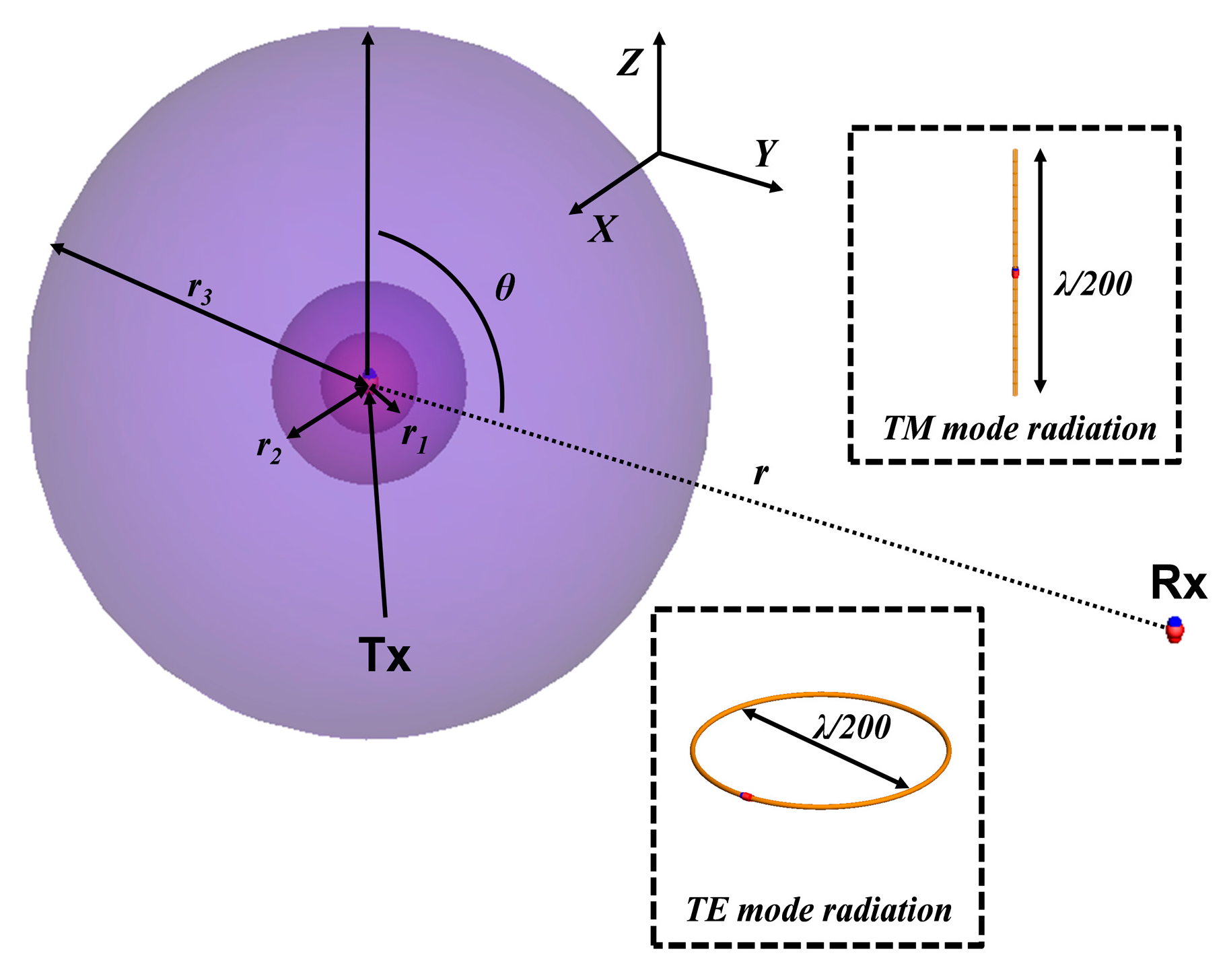
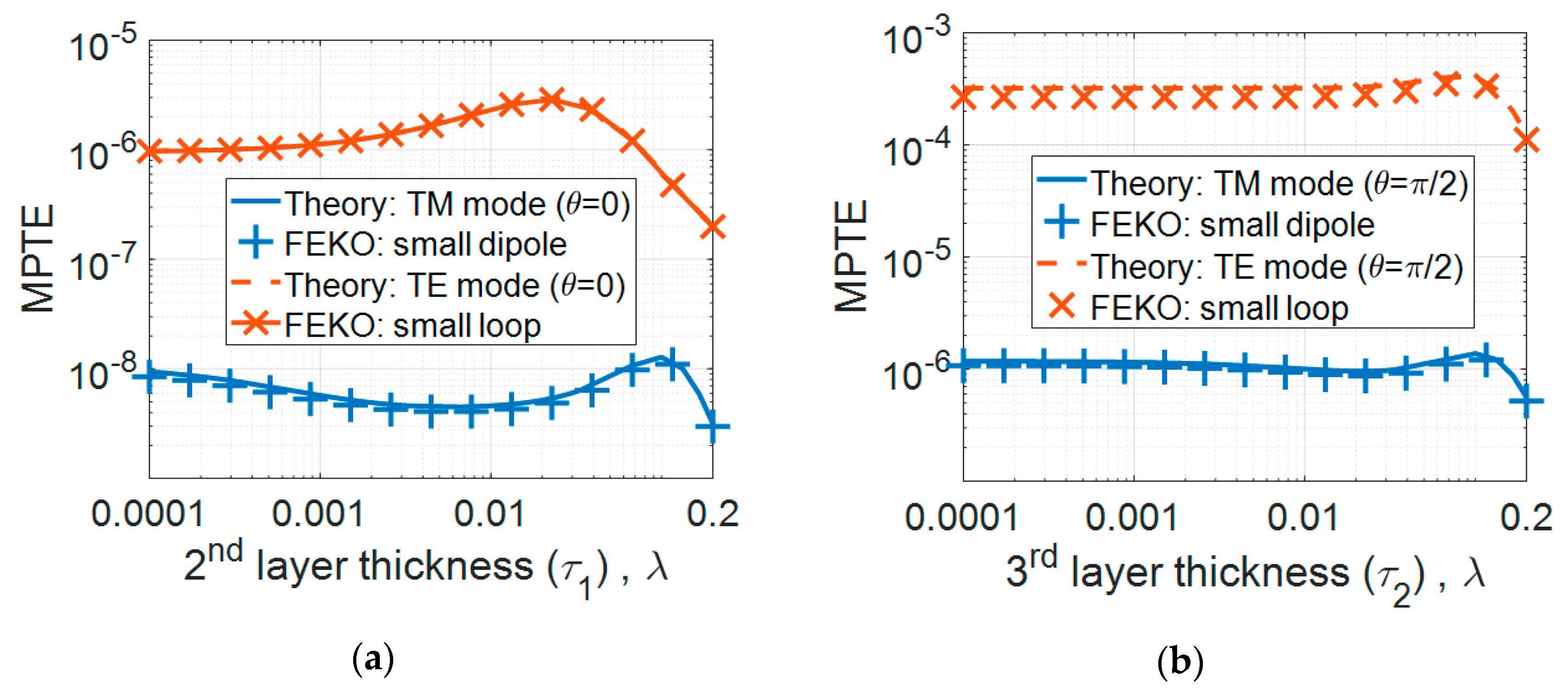

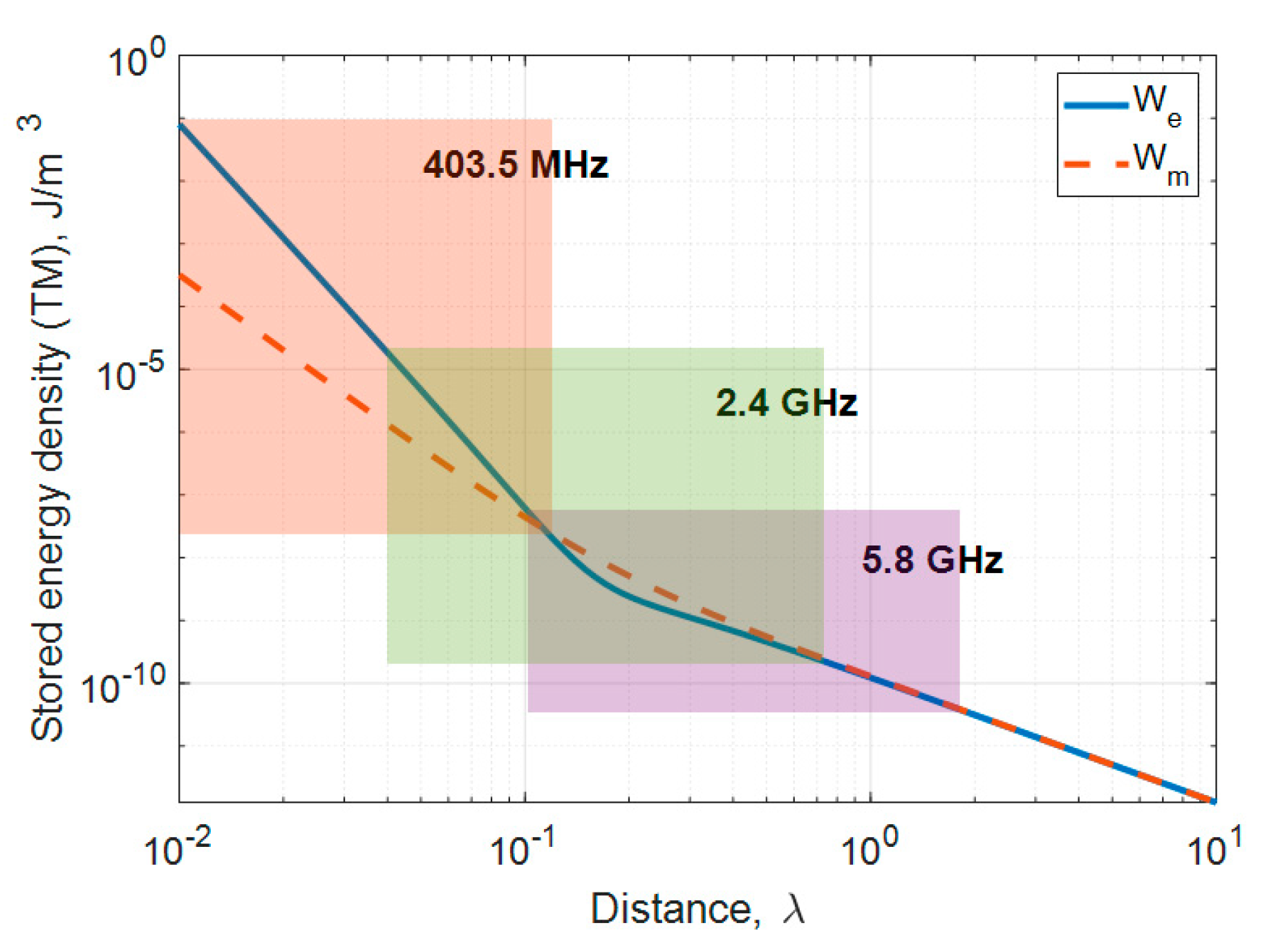
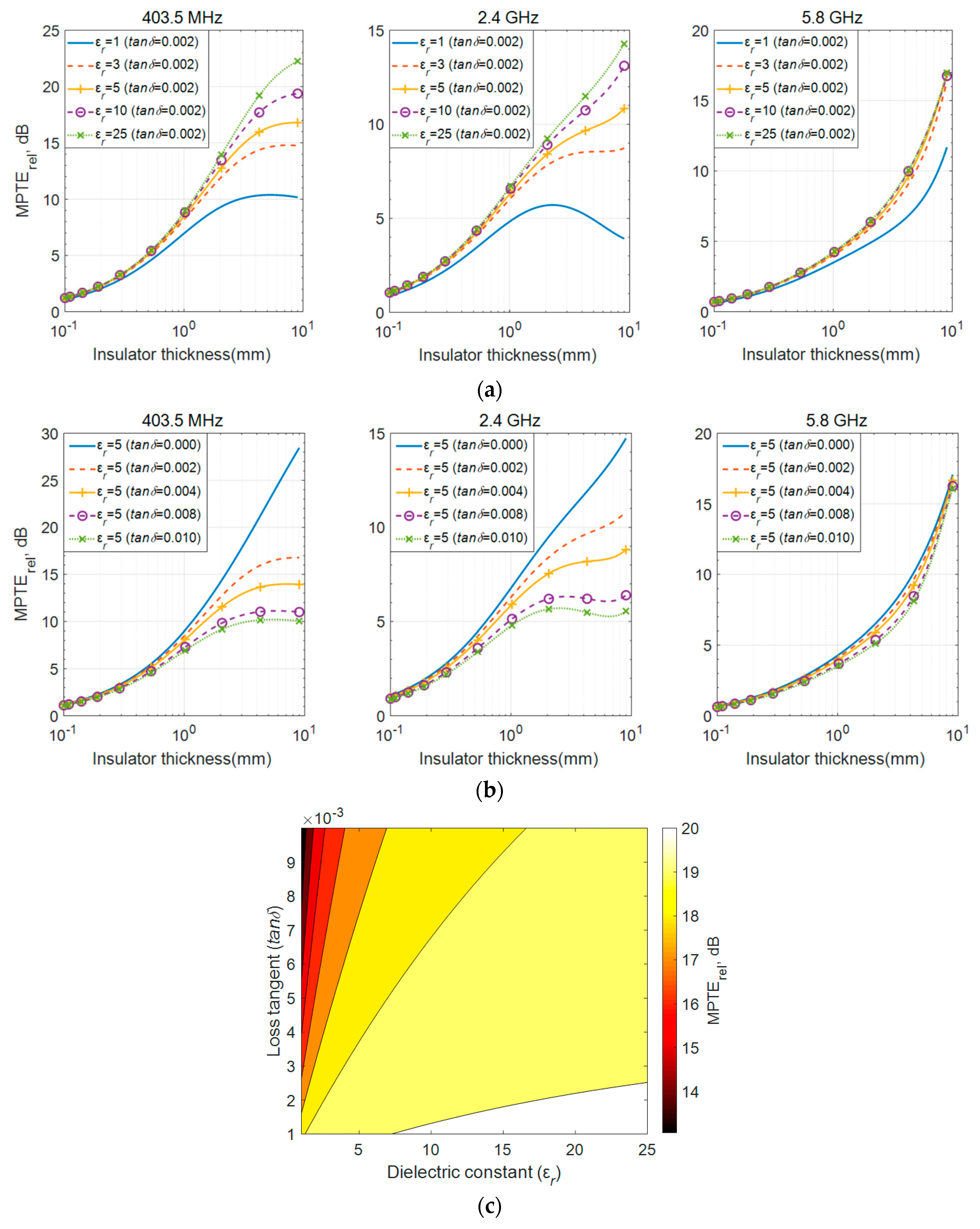
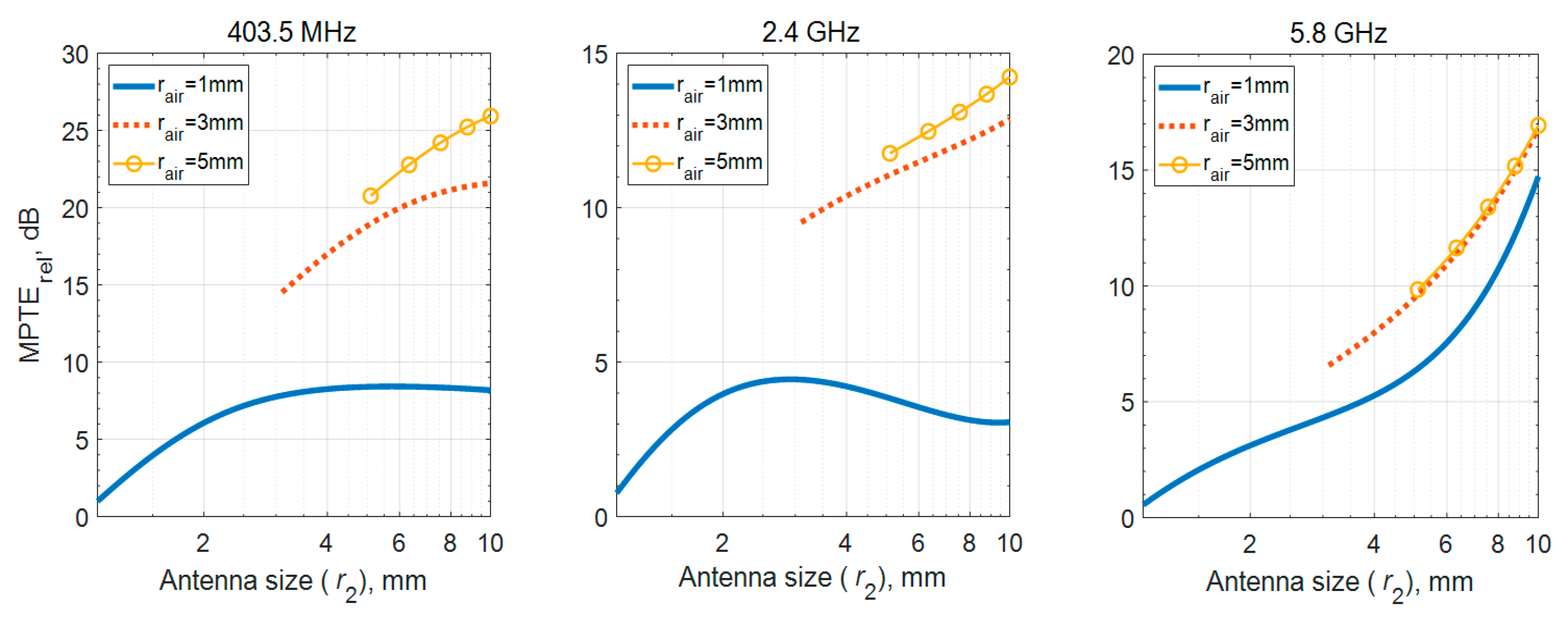
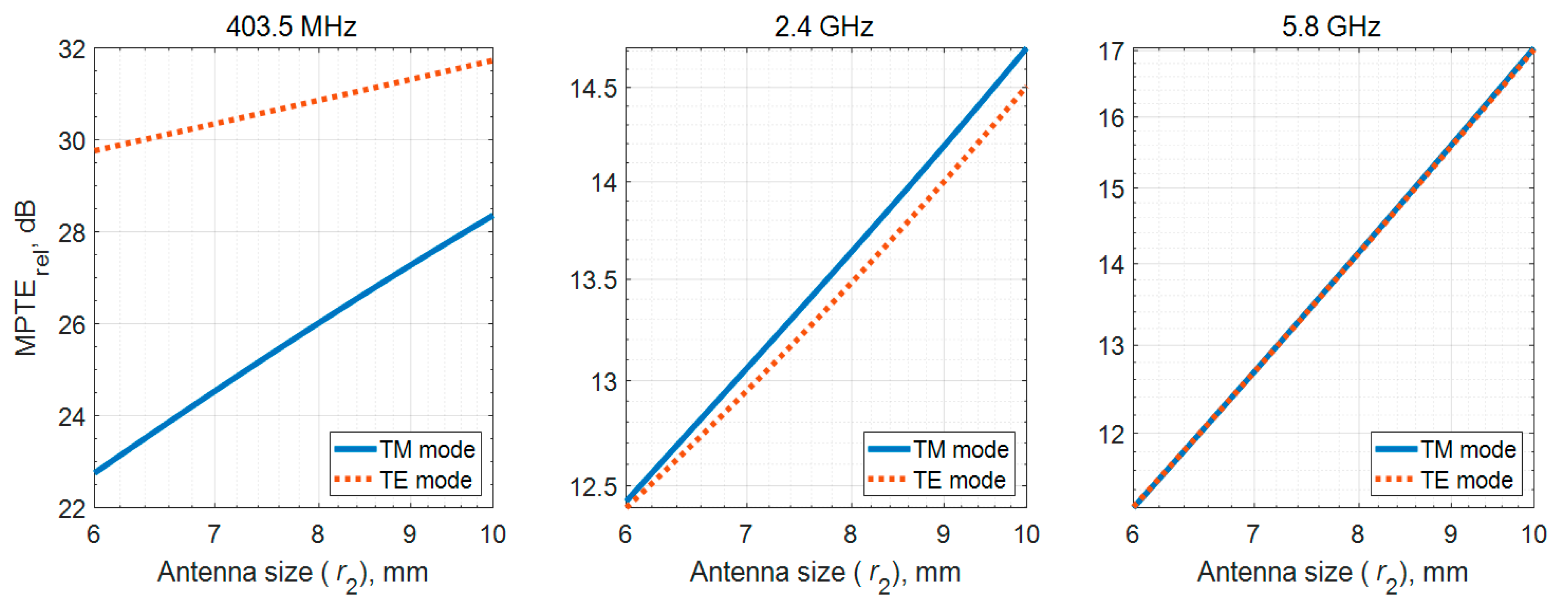
| Material | Dielectric Constant (εr) | Loss Tangent (tanδ) |
|---|---|---|
| Polypropylene * | 2.55 | 0.003 |
| Peek * | 3.20 | 0.010 |
| Polyamide * | 4.30 | 0.004 |
| Alumina * | 9.20 | 0.008 |
| Zirconia * | 29.0 | 0.002 |
| Head tissue (400 MHz) | 43.5 | 0.799 |
| Head tissue (2.4 GHz) | 39.2 | 0.344 |
| Head tissue (5.8 GHz) | 35.3 | 0.463 |
| MPTE (Absolute) | MPTE (w/o Insulator) | Improved MPTE (Relative) | |
|---|---|---|---|
| r − r3 = 1 cm and θ = 0 | 1.11 × 10−17 | 4.51 × 10−18 | 3.911 dB |
| r − r3 = 1 cm, and θ = π/2 | 1.64 × 10−24 | 6.67 × 10−25 | 3.907 dB |
| r − r3 = 5 m, and θ = 0 | 4.01 × 10−16 | 1.63 × 10−16 | 3.910 dB |
| r −r3 = 5 m, and θ = π/2 | 1.57 × 10−19 | 6.38 × 10−20 | 3.911 dB |
© 2019 by the authors. Licensee MDPI, Basel, Switzerland. This article is an open access article distributed under the terms and conditions of the Creative Commons Attribution (CC BY) license (http://creativecommons.org/licenses/by/4.0/).
Share and Cite
Shin, G.; Yoon, I.-J. Investigation on Insulated, Brain-Implanted Antenna for Highly Reliable Biotelemetry Communication in MICS and ISM Bands. Sensors 2020, 20, 242. https://doi.org/10.3390/s20010242
Shin G, Yoon I-J. Investigation on Insulated, Brain-Implanted Antenna for Highly Reliable Biotelemetry Communication in MICS and ISM Bands. Sensors. 2020; 20(1):242. https://doi.org/10.3390/s20010242
Chicago/Turabian StyleShin, Geonyeong, and Ick-Jae Yoon. 2020. "Investigation on Insulated, Brain-Implanted Antenna for Highly Reliable Biotelemetry Communication in MICS and ISM Bands" Sensors 20, no. 1: 242. https://doi.org/10.3390/s20010242
APA StyleShin, G., & Yoon, I.-J. (2020). Investigation on Insulated, Brain-Implanted Antenna for Highly Reliable Biotelemetry Communication in MICS and ISM Bands. Sensors, 20(1), 242. https://doi.org/10.3390/s20010242




